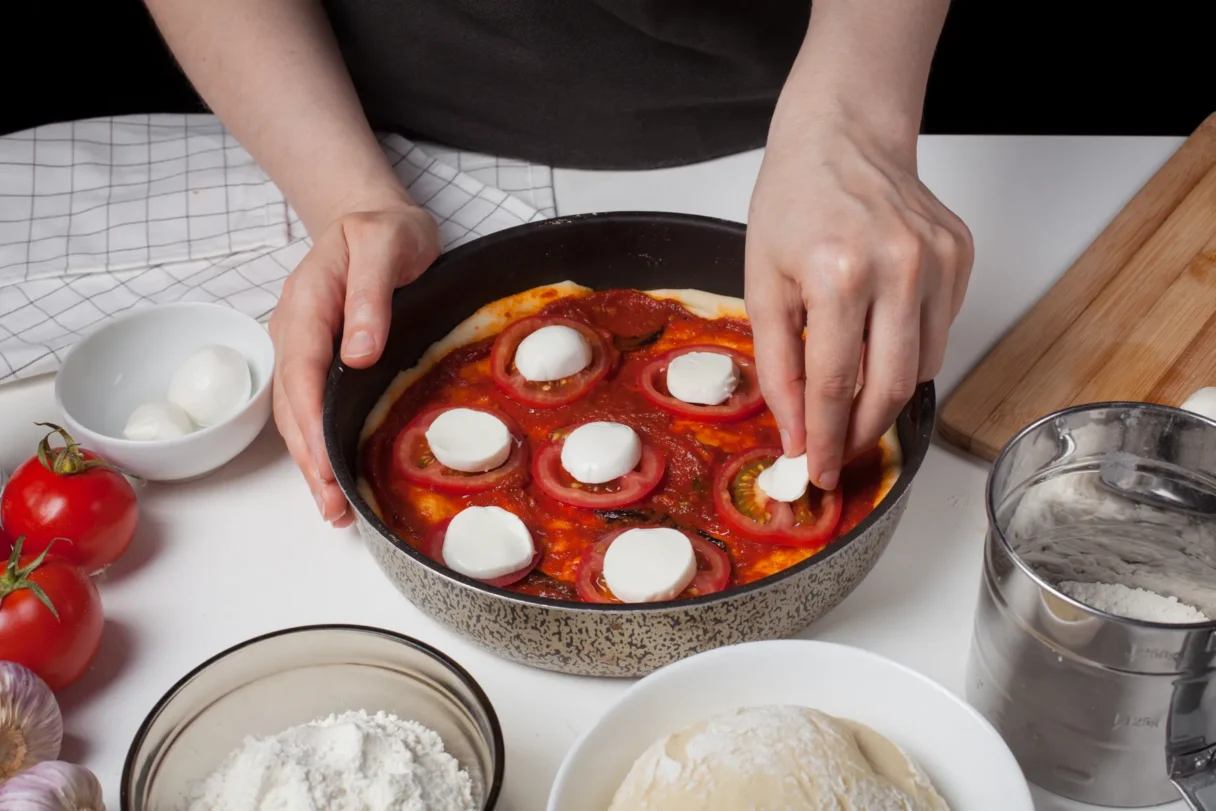
Elevate Cuisine with Traditional Italian Cooking Techniques
Introduction
Get lost in the world of culinary arts, where history, creativity, and taste all come together. Learning Traditional Italian Cooking Techniques will take your cooking to a new level. Traditional Italian cooking has fresh, rich, and varied flavors. It also has a wealth of skills refined over hundreds of years that you can learn and use in your kitchen.
Please read our blog on Essential Techniques.
Foundations of Italian Cooking
Italian food is simple and focuses on using fresh, high-quality products in season. Here are some essential parts:
The Use of Fresh Ingredients:
Italian food is famous for using fresh, in-season products that make the food taste better.
Regional Variations:
Many of Italy’s areas have their cooking styles, dishes, and ingredients. This variety of foods from different regions is an integral part of Italian food culture.
The Role of Staples:
Pasta, olive oil, and tomatoes are the main ingredients in Italian food and are used in many ways.
Simplicity of Preparation:
Many Italian meals are made in simple ways so that the flavors of the ingredients can shine through.
Time-honored Techniques:
Traditional methods are essential in Italian food, from making pasta from scratch to slowly cooking sauces.
Balancing Flavors:
Italian food also balances and contrasts different tastes, like using sweet and sour (agrodolce).
You can use Italian cooking methods more authentically when you understand these basics.
The Art of Pasta Making
Making pasta from scratch is an essential part of traditional Italian cooking. It teaches you the methods that have shaped Italian food for hundreds of years. Here are some important steps:
Choosing the Right Flour:
The thickness of your pasta will depend a lot on the type of flour you use. “00” flour is a finely ground Italian flour often chosen because it makes it smooth and easy to work with dough.
Creating the Dough:
In the usual way of making pasta dough, you make a “well” with the flour and add the eggs in the middle. Then, the ingredients are mixed gradually until a stiff dough forms.
Kneading the Dough:
Kneading is an essential step because it strengthens the flour’s gluten, which gives pasta its chewy structure. Knead the dough until it is smooth and stretchy.
Resting the Dough:
The dough needs to rest before it can be rolled out and shaped. This step lets the gluten loosen up, which makes it easier to shape the dough.
Rolling and Shaping:
Whether the dough is rolled out by hand or with a pasta machine depends on the type of pasta being made. It can then be cut or shaped however the person wants.
Cooking the Pasta:
It takes a lot less time to cook fresh pasta than dried pasta. It is often put into a pot of salted boiling water and cooked until “al dente,” which means it’s not entirely soft but still holds its shape when eaten.
Learning how to make pasta is a great way to improve your Italian food, turning simple items into a dish that tastes genuinely Italian.
Sauces and Flavorful Foundations
Sauces, the flavorful bases of many Italian meals, often make the food unique. You can make these culinary wonders in your own home by following these steps:
Tomato Sauce:
Simple tomato sauce, or “sugo di pomodoro,” is an integral part of Italian food. This sauce is usually made by slowly cooking fresh or canned tomatoes, garlic, and olive oil until right. Some versions may also add herbs like oregano or basil for extra flavor.
Bolognese Sauce:
The rich meat sauce called “Ragu alla Bolognese” comes from Bologna. It is usually slow-cooked with beef, pork, tomatoes, onions, celery, carrots, and wine. People often put it on top of tagliatelle or use it in lasagne.
Pesto:
Pesto comes from Genoa and is a bright, fresh sauce made from garlic, basil leaves, pine nuts, Parmigiano-Reggiano, Pecorino Romano, and extra virgin olive oil. It tastes good with some meats, pasta, and bread.
Alfredo Sauce:
Alfredo sauce is made from butter, Parmigiano-Reggiano cheese, and heavy cream. It is a rich and smooth sauce. It’s less common in Italy but famous worldwide, especially with fettuccine.
Carbonara Sauce:
An old Roman sauce called carbonara is made with eggs, black pepper, bacon or guanciale, and cheese (Pecorino Romano or Parmigiano-Reggiano). Even though it looks smooth, authentic carbonara has no cream; the eggs and cheese make a milky texture.
This information about these sauces and their making will help you learn much about Italian cooking and make authentic Italian flavors at home.
Mastering Risotto
Another vital dish in Italian food is risotto, a creamy and comforting rice meal. It’s easy to learn how to make risotto if you follow these steps:
Choosing the Right Rice:
The most popular types of rice used for risotto are Arborio, Carnaroli, and Vialone Nano. Because they have a lot of starch, they give risotto its smoothness.
Toasting the Rice:
First, use butter or olive oil to cook onions or garlic. Then, add the rice and stir it around until the grains are covered in fat and just barely see-through. This is called “toasting.” This step helps the rice take in taste and keep its shape while it cooks.
Deglazing the Pan:
Put a little white wine into the pan and stir until it’s gone. By “deglazing,” you free up any tasty bits stuck to the pan’s bottom. This gives the dish more depth.
Adding the Stock:
Slowly add hot stock while stirring all the time. Don’t add more until the last bit of stock has been absorbed. Adding the liquid is the key to getting the right creamy consistency.
Cooking the Rice:
Keep cooking the rice until it’s “al dente,” which means it’s firm but not hard. It should take about 18 to 20 minutes to do everything.
Finishing the Risotto:
After that, take the rice off the heat and add some butter and freshly grated Parmigiano-Reggiano. This will give it a flavor boost and make it creamier. “Mantecatura” is the word for this last step.
Resting the Risotto:
Take a short break from serving the risotto so that the tastes can start to blend.
It takes time to get good at making risotto, but once you do, you can play around with different flavors and ingredients to make it your own.
Perfecting Italian Pizza
Pizza from Italy is famous worldwide for being straightforward, using good ingredients, and being baked traditionally. Here’s how to make this famous Italian dish just right:
Choosing the Right Flour:
’00’ flour is the best for making an authentic Italian pizza. Because it is finely ground and high in gluten, it makes pizza dough that is light and easy to stretch.
Creating the Dough:
Mix the flour, yeast, water, and salt to make the dough. It’s important not to work it too hard; mix it until it comes together and all the flour is mixed in. Let it sit for a while, then knead it until it’s smooth and stretchy.
Proofing the Dough:
Please wait for the dough to rise until it’s twice as big. This could take anywhere from one to twenty-four hours, based on the recipe and how warm your kitchen is. This process, “proofing,” makes the dough taste and feel better.
Shaping the Pizza:
Please don’t use a rolling pin to make your dough when ready; gently stretch it with your hands. With this process, you can make the “cornicione,” a thin middle with a slightly thicker edge.
Adding Toppings:
Simple, high-quality products are often used to top authentic Italian pizzas. For example, all you need for a standard Margherita is tomato sauce, fresh mozzarella, basil, and a drizzle of olive oil.
Baking the Pizza:
To get the best results, bake your pizza in a hot oven or, even better, one fired with wood. It will cook quickly over the high heat, leaving the top crispy and slightly charred while the inside stays soft and chewy.
Resting the Pizza:
After taking it out of the oven, give your pizza a minute or two to cool down. This will help you cut it more efficiently and allow the cheese to set a bit.
By paying attention to these important things when you make your pizza, you’ll be well on your way to making an authentic Italian pizza.
Italian Seafood Mastery
Seafood is an integral part of Italian food, especially in the seaside areas. To get good at making Italian seafood meals, keep these tips in mind:
Choosing Fresh Seafood:
The fish should be as fresh as possible for the best dish. When you buy fish, look for eyes that are clear and bright and meat that is hard and shiny. Mussels, oysters, and clams should be heavy for their size, and the shells should be closed tightly.
Simple Seasonings:
Italian cooking is all about bringing out the natural tastes of food, so add less seasoning to seafood. Often, all you need is a little extra-virgin olive oil, fresh lemon juice, salt, and pepper that has just been ground.
The Right Cooking Method:
Could you match the type of fish you’re cooking with the right way to cook it? They are often pan-seared or baked to keep the delicate tastes of fish like soles and sea bass. On the other hand, lobster and clams can handle being grilled or broiled.
Pairing with Pasta:
Pasta and seafood go very well together. This combination works well in classic meals like Spaghetti alle vongole (spaghetti with clams).
Serving with Wine:
For an authentic Italian meal, pair your fish with a crisp white wine like Vermentino or a light-bodied red wine like Valpolicella.
Exploring Regional Dishes:
In different parts of Italy, fish is unique to that area. People from Sicily love seafood risotto, people from Liguria love fish stew, and people from Veneto love squid ink pasta.
If you learn these skills, you can make authentic and tasty Italian seafood dishes. Have fun with the process, and have a great meal!
The Importance of Olive Oil
A big part of the Mediterranean diet is olive oil, the base for many Italian recipes. This is why it’s so important:
Flavor Profile:
Olive oil gives food a unique, fruity flavor that brings out the best in other products.
Health Benefits:
Olive oil is good for you in many ways, like fighting inflammation and keeping your heart healthy because it is high in monounsaturated fats and vitamins.
Cooking Properties:
Because it has a high smoke point, olive oil can be used for many types of cooking, such as smoking, frying, and sautéing.
Varieties:
Different kinds of olive oil, like extra virgin, virgin, and pure olive oil, taste different and can be used in various ways in the kitchen.
Ingredient Pairings:
When you cook Italian, olive oil goes well with many things, like tomatoes, garlic, basil, and fish.
Cultural Significance:
In Italy, olive oil is essential to the culture and is often used in traditional ceremonies and parties.
By understanding how vital olive oil is, you can better enjoy and understand the subtleties of Italian food.
Regional Specialties and Varieties
As different as Italy’s landscape is, so is its food. Each area has its unique dishes and ingredients. Here are some well-known regional flavors and types:
Tuscany:
The food in Tuscany is known for being rich and rustic. Dishes like Pappa al Pomodoro, Bistecca alla Fiorentina (T-bone steak), and Ribollita (bread soup) are well-known.
Emilia-Romagna:
This area is famous for its rich and delicious food and is considered Italy’s food center. It’s where lasagna, pasta, and the well-known Bolognese sauce were created.
Sicily:
Many different countries have influenced Sicilian food. Some examples are Arancini (stuffed rice balls), Caponata (eggplant dish), and Cannoli (dessert pastry).
Campania:
Campania is home to Naples, which is where pizza was first made. It also has foods like Spaghetti alle Vongole (clam pasta) and Baba al Rum (a cake soaked in rum).
Lombardy:
Lombardy is known for its high-class foods, like Osso Buco (braised veal shanks), Polenta, and Risotto alla Milanese.
Veneto:
Along with its famous cuttlefish ink pasta, Veneto serves Bigoli (thick spaghetti) and Tiramisu (a treat that tastes like coffee).
Try these regional dishes to understand Italy’s rich culinary history better.
Desserts: A Sweet Conclusion
A sweet ending is a must for any Italian meal. When making Italian treats, keep these essential things in mind:
Quality of Ingredients:
Regarding Italian food, the quality of the products is essential. Use fresh, high-quality products to ensure your desserts taste and feel their best.
Variety:
Desserts in Italy vary from easy ones like fruit tarts to more complicated ones like cannoli. To fully experience this part of Italian food, try several different recipes.
Regional Specialties:
There are classic desserts from each part of Italy. You can think of desserts like Tiramisu from Veneto, Cannoli from Sicily, and Panna Cotta from Piedmont.
Wine Pairings:
Dessert wines go well with a lot of Italian sweets. A Moscato d’Asti or Vin Santo can go well with your sweet treat.
Presentation:
Italians are proud of how their food looks, and sweets are no different. For an authentic Italian experience, please take the time to make your desserts classy.
You can make a sweet ending for any Italian meal if you learn these skills.
Conclusion
Finally, learning how to use traditional Italian cooking techniques is essential for getting the natural flavors of this wide-ranging and complex food. Every step in the cooking process in Italy is different, from choosing the right products to being very careful about how you cook seafood, using olive oil, trying new regional dishes, and making sweet treats. If you use these tips, you can bring a little bit of Italy into your home and enjoy the pleasures of Italian food. Enjoy your meal!
Mary Johnson
Mary Johnson loves trying new recipes and teaching others. With years of cooking experience, she creates inspiring, delicious recipes. Her writing combines creativity and pragmatism, making cooking fun and easy for everyone.



